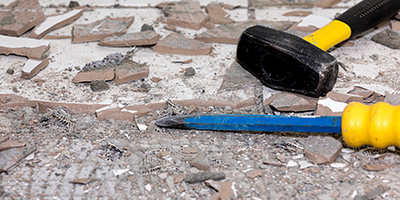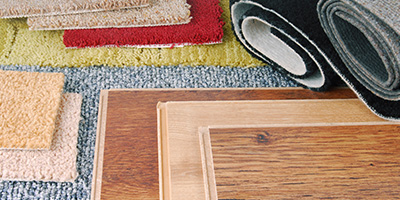How to Choose Tile for Every Room in Your Home

How to Choose Tile For Every Room
If you’re considering tile for your next home improvement project, you have your pick of a wide range of materials and designs, from eye-catching glass backsplashes and patterned shower walls to marble flooring and granite tile countertops. However, it’s important to note that all types of tile aren’t intended for all spaces.
Follow along as we explore how to choose the right tile for any style and budget, along with tile trends and tips from industry experts.
Things to Consider When Choosing Tile
With so many different types of tile available, it can be difficult to know where to begin when choosing the right one for your home. Before we dive into six of the most popular types of tile, it’s important to understand the most important characteristics to consider, including the durability, size, color, location and cost of each tile.
Tile Hardness
Tile hardness is classified by Porcelain Enamel Institute (PEI) ratings, from 1-5.
- Class I tile is best used in areas with no foot traffic, and recommended for wall use only.
- Class II tile is intended for areas with light traffic, such as walls and bathroom flooring.
- Class III tile should be used in light to moderate traffic areas, including countertops, walls and residential floors (not recommended for flooring in kitchens and entryways).
- Class IV tile, good for moderate to heavy traffic, can be installed in all areas of the home, including kitchens, halls and entryways.
- Class V tile is used for flooring in heavy to extra-heavy traffic areas, and typically only in commercial spaces.
Tile Durability
In addition to hardness, a tile’s durability is determined by porosity, or how much moisture a type of tile absorbs. There are four ratings for a tile’s moisture absorption.
- Impervious tile (extremely high density) has a water absorption rate of 0.5% or less, and is recommended for use in kitchens and bathrooms, as well as outdoor areas.
- Vitreous tile (high density) has a water absorption rate of 0.5% – 3%, and can be used in bathrooms or outdoors.
- Semi-vitreous tile (medium density) has a water absorption rate between 3% – 7%, and is not suitable for use in bathrooms or outdoors.
- Non-vitreous tile (low density) has more than 7% water absorption, and is not recommended for floor use.
Style
Each of the different types of tile has its own style, varying by color, shape, size and texture.
Choosing your tile color sets the stage for the whole feel of a room. Lighter colored tiles can make a room look larger, while darker tiles add warmth to a room. There are also a variety of shapes and patterns you can find in tile. Trending tile looks include subway, hexagon, herringbone and penny round, though these designs are best used for smaller areas such as a backsplash or shower wall. For most flooring areas, simpler rectangle or square shapes typically look best.
Beyond shape, size matters when choosing tile. When choosing flooring for instance, large tiles can make small areas feel larger, and small tiles can make a room feel more intimate. Size also impacts installation and upkeep, as small tiles have more grout lines and take more time and effort to install than larger ones.
Finally, the texture of a tile is important to consider based on its location. Smooth surfaces are easy to clean and great for walls and backsplashes, but can get slippery and aren’t an optimal choice for flooring in bathrooms and kitchens. Textured tiles can be tougher to clean, but are durable and scratch-resistant for flooring in high-traffic areas.
Cost
While durability and style are important factors when choosing tile, picking a material that aligns with your budget is equally important. The cost of tile is usually broken down by square foot, though they can be sold in cases as well. Tile installation cost is also broken down by square foot, and is in addition to the base cost.
HomeAdvisor reports that the labor costs for tile installation range from $4 – $32 per square foot on average, with flooring installation costing between $4 – $14 per square foot and countertop and backsplash installation costing between $25 to $32 per square foot.
Maintenance
Another important consideration when choosing tile is the practical upkeep it will require in your home. We’ll keep this rating at a general level, summarizing if a type of tile is easy or difficult to maintain.

“As you begin your search for new wall or floor tile, consider your personal style, your budget and installation costs. You want to make sure you get something you’re going to love for years to come, and at a price you can afford.”
Chelsi Hewitt, Flooring Inc.
Breaking Down the Top 6 Types of Tile
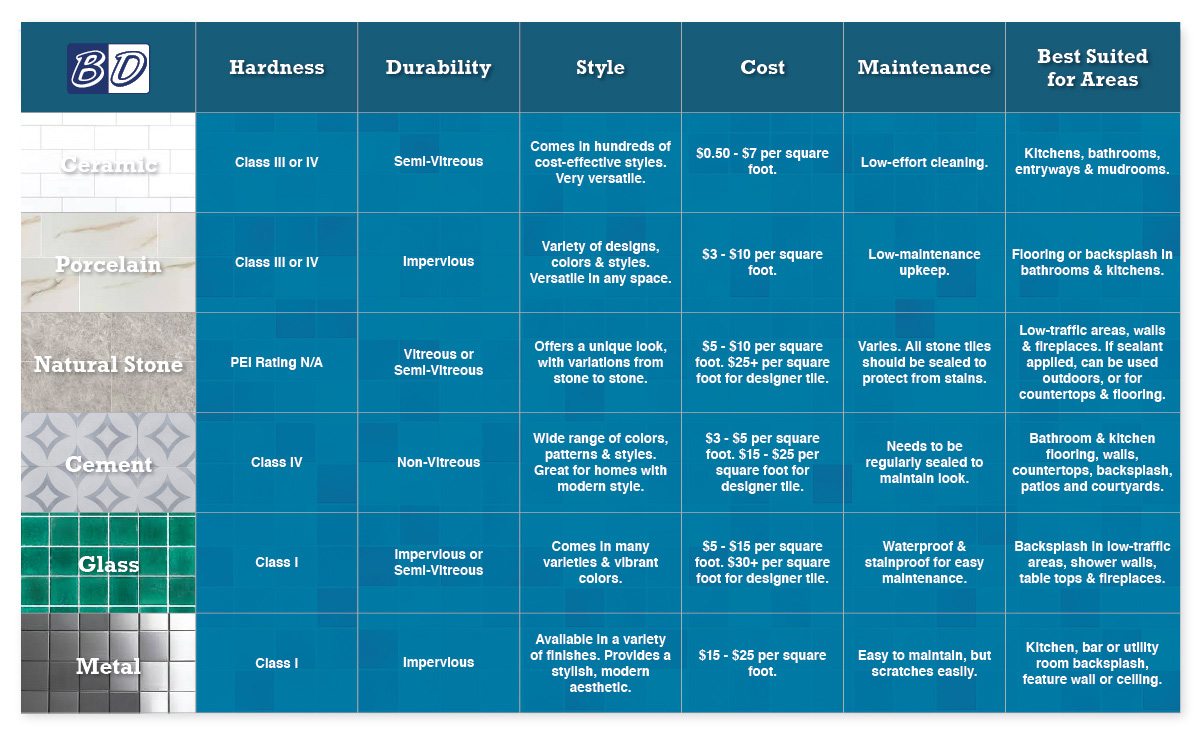
1. Ceramic Tile
Ceramic tile is the most common tiling used in the US, and it’s suitable for just about every room in the house. With hundreds of styles to choose from, and most at reasonable price points, it’s easy to see why ceramic tile is one of the most popular types of tile. Plus, it’s low-maintenance and easy to install.
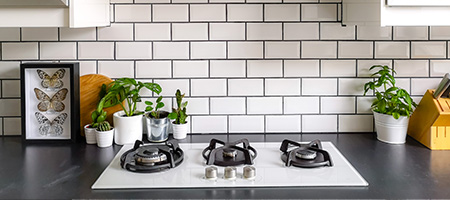
Glazed ceramic tile is typically used in homes, as its liquid glass coating helps resist scratches and stains for longer-lasting floors and surfaces. Unglazed ceramic tile, also known as quarry tile, has an artistic, rustic finish and even color throughout, but must be treated to prevent stains. Quarry tile is durable and naturally water-resistant, and is commonly used for kitchen floors and pathways.
Hardness & Durability: Semi-vitreous and durable enough for most residential uses (Class III or IV Hardness).
Style: Comes in hundreds of styles, most of which are very cost-effective. Glaze is added after firing to create the tile color, allowing for a lot of variety. Terra cotta and subway tiles are very versatile and can be used in most rooms. Ceramics can also mimic the look of hardwood with a lower risk of scratches.
Tile Cost: $0.50 – $7 per square foot, on average.
Maintenance: Easy to install and clean, making for low-effort maintenance.
Best Suited For: Kitchens, bathrooms, entryways and mudrooms. Flooring for main living areas in warmer climates and areas where sand and dirt can get dragged in. Not recommended for outdoor use.
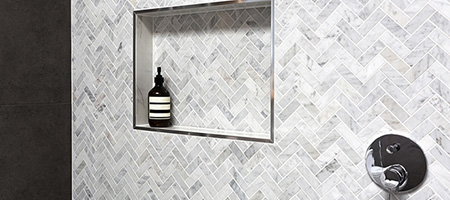
2. Porcelain Tile
The second most common type of tile is porcelain. It’s made of finer-grained clay than ceramic and fired at a higher temperature, making it a denser and more moisture-resistant option.
The price of porcelain tile is typically higher than ceramic due to the quality of material and production labor involved, though it’s less subject to wear and tear and is still considered relatively affordable. Note: because porcelain is heavier than other tiles, it is not recommended for use in large second or third-floor projects.
Hardness & Durability: Impervious, durable and long-lasting (Class IV or V Hardness).
Style: Porcelain’s variety of designs, colors and styles allow it to be versatile in any space. Can emulate natural stone, brick or wood without the upkeep those materials require.
Tile Cost: $3 – $10 per square foot, on average.
Maintenance: Installation can be tricky, but the tile itself is considered to be low-maintenance. It is less porous and more stain-resistant than ceramic tile, and won’t hold onto dirt or dust, making it ideal for those with allergies.
Best Suited For: Flooring or backsplash in high-traffic areas, such as bathrooms or kitchens.

“High-quality porcelain is almost always more expensive than high-quality ceramic since it’s [denser and more durable] than the latter. However, there are porcelain tiles that are cost comparative to ceramic tiles, depending on the look you’re going for. Ceramic usually has the most inexpensive options, and that’s a great way to replace carpet flooring if you’re looking for an upgrade.”
Kayla Haas, Flooring Inc.
3. Natural Stone Tile
Natural stone tile encompasses a variety of sub-types, including marble, granite, limestone, travertine and sandstone. It is one of the most expensive types of tile, and most homeowners use it for decorative features, as upkeep can be difficult and large quantities of natural stone tile can be very costly.
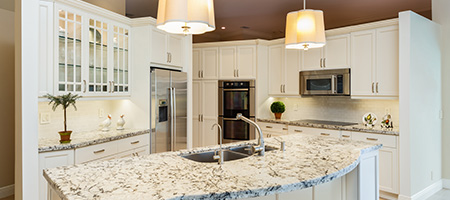
Hardness & Durability: Vitreous or semi-vitreous, and durability varies based on type of stone (PEI rating not applicable, as this product is from nature and not manufactured or glazed).
Style: Offers a unique look, with variations from stone to stone. Marble and granite offer a luxurious air and are usually used for countertops, backsplashes and mosaic shower walls. Limestone, travertine and sandstone offer a rustic, natural appearance and are more durable, making them ideal for use in kitchen flooring or backsplashes.
Tile Cost: $5 – $10 per square foot, on average. Designer tile can be $25+ per square foot.
Maintenance: The majority of natural stone tiles are slippery, prone to scratches and stains, and difficult to clean due to their porous texture. Granite is an extremely scratch-resistant natural stone tile option, but needs to be sealed to protect its permeable surface from absorbing liquids.
Best Suited For: Low-traffic areas, such as walls and fireplaces. If used for countertops, flooring or outdoors, a sealant must be applied. Not recommended for high-moisture areas, such as showers or bathroom floors.

"Stone looks are extremely popular in kitchens and bathrooms. To get the most timeless stone look, we suggest sticking to marble, limestone or slate. They look clean and elegant, and they will each hold up to the surge in wood-look competition."
Chelsi Hewitt, Flooring Inc.
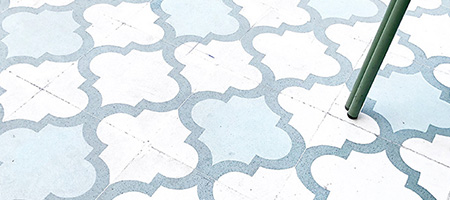
4. Cement Tile
Cement tiles, also known as concrete tiles, have been growing in popularity for residential use. While concrete has been around for hundreds of years, pigmented cement has become a huge home tile trend due to its unique look and durability.
Cement tile is eco-friendly, thick and water-resistant, making it suitable for both indoor and outdoor use. However, it is more costly and labor-intensive to install than other types of tile, so it’s best used in smaller quantities.
Hardness & Durability: Non-vitreous, very durable and suitable for both residential and commercial areas (Class IV Hardness).
Style: Available in a wide range of different colors, patterns and sizes, and great for homes with a modern style. Since cement is very porous, a patina (fading or darkening) can develop over time, which can enhance colors and patterns, but might not match everyone’s style.
Tile Cost: $3 – $5 per square foot, on average. Patterned designer tiles can be $15 – $25 per square foot.
Maintenance: Installation of cement tile requires specialized tools and skill sets, so it’s not recommended for a DIY project. Grout isn’t always needed, which can make choosing this type of tile appealing, depending on where it’s being installed. While durable, cement tile will need to be regularly sealed to maintain its look. Concrete can also be refinished over and over to continuously freshen its look.
Best Suited For: Concrete tile is long-lasting and slip-resistant, making it an attractive option for bathroom and kitchen floors, as well as for outdoor use. Suitable for flooring, walls, countertops, backsplash, patios and courtyards.

“Once you’ve made your decision [on a new tile], we advise people to hire a professional for installation. Tiles can be difficult to install, and you don’t want to ruin your new walls or flooring with a poor installation job. Hiring a pro can be pricey, however, so you want to build that cost into your budget.”
Chelsi Hewitt, Flooring Inc.
5. Glass Tile
Glass tile is known for bringing a bright, translucent look into any space. It is often used to make mosaic patterns in backsplashes and accent walls, and typically is not used for flooring in high-traffic areas.
Glass tile is cut smaller and installed with more grout lines than other types of backsplash tile, so the surface is more textured, slip-resistant and easier to clean. Glass resists moisture and stains, but it’s a fragile material so should be used in smaller spaces with minimal traction.
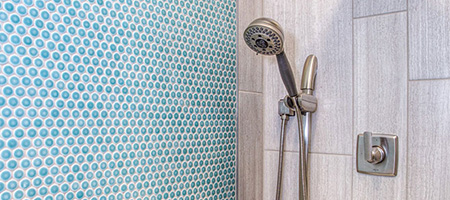
Hardness & Durability: Impervious or semi-vitreous. Stain-resistant, but edges are prone to chipping (Class I Hardness).
Style: Comes in many varieties and vibrant colors, and is a great alternative to natural stone for decorative accents in the home.
Tile Cost: $5 – $15 per square foot, on average. Designer tile can be $30+ per square foot.
Maintenance: Glass installation is an expensive specialty job, so this is not recommended as a DIY project. It’s water and stainproof, making it easy to maintain with all-purpose glass cleaner and a cloth.
Best Suited For: Backsplashes, shower walls, table tops and fireplaces. Glass tile easily chips, so it’s not recommended for high-traffic areas.
Picked the Perfect Tile? Now Learn How to Install it in Six Simple Steps.
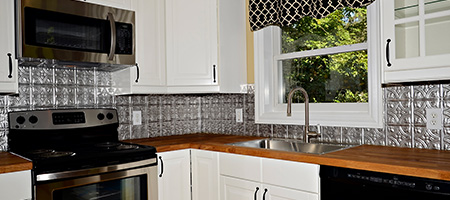
6. Metal Tile
Metal tile is most often seen as an accent in kitchen or bar backsplashes. The cost of this tile is similar to natural stone, so it’s not as cost-effective. However, you’ll typically only use metal tile in small quantities, so a little bit goes a long way.
Hardness & Durability: Impervious, though easily scratched and dented (Class I Hardness).
Style: Provides a stylish, modern aesthetic. Available in a variety of finishes, as well as in a peel-and-stick format which is popular for kitchen backsplashes. Can be used with or without grout, depending on personal taste.
Tile Cost: $15 – $25 per square foot, on average.
Maintenance: Easy to install and maintain. Its tendency to scratch can soften its shine, so this is not the right choice for homeowners wanting a pristine finish.
Best Suited For: Kitchen, bar or utility room backsplash, feature wall or ceiling. Not recommended for bathrooms or outdoors, and not an ideal flooring choice as these tiles are easily damaged and can be cold to walk on.

“I recommend you do lots of research to discover the best tile for you. There are plenty of resources to help you find your style. Search home improvement blogs to gather inspiration and learn about the latest tile trends. Once you find a style you like, you can focus in on the most budget-friendly options for you.”
Chelsi Hewitt, Flooring Inc.
How to Choose the Right Tile for Your Home
When deciding between all the different types of tile, there are so many factors to consider. By going through your options step by step and sticking to your vision for your home’s design, you can confidently choose the right tile for every room in your home.

